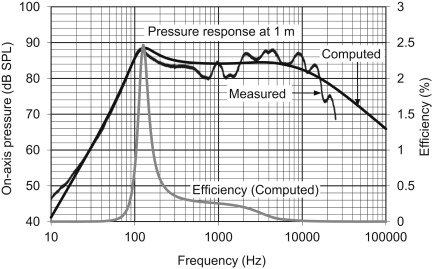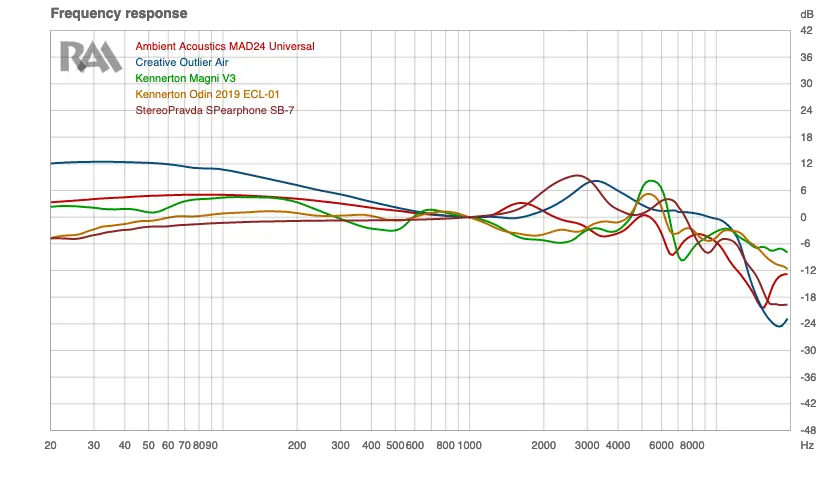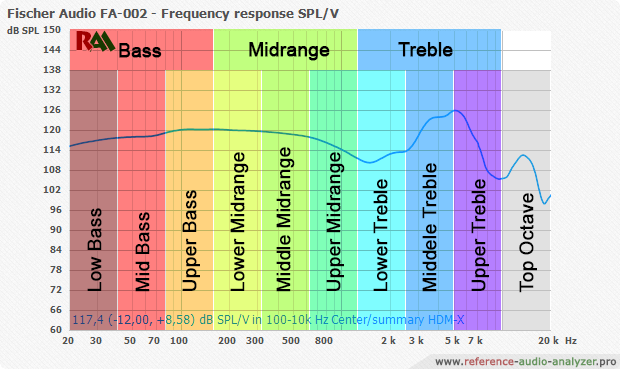By: Jeremy Neisser
Frequency response in headphones is one of the key specifications for any pair of headphones. A frequency response graph represents how well (or poorly) a set of headphones can reproduce sound across all audible frequencies.
Before we continue, it's important to note that frequency is measured in Hertz (Hz), or cycles per second. Humans can hear from 20Hz to about 22,000Hz. Sub-bass frequencies are generally anything under 80Hz, the bass is from 80Hz to 250Hz, the midrange is 250Hz to 2kHz and high frequency (treble) is anything above 2kHz.
Since my site talks a ton about amateur radio and CB radios, it is important to keep our ears healthy when listening to transmissions.
Different people can hear different things at different volumes and it's important not to take any of the following specs too seriously. Most people are not able to hear above 14kHz at all and most experts agree that once you get below 80Hz, more amplitude (volume) is required to actually detect a difference.
What is Frequency Response in Headphones?
There are tons of headphones on the market today with frequency ranges that extend into the "questionable" territory.
For example, some popular brands have frequency ranges of 6Hz-23kHz! While I personally question the usefulness of this range - it does provide an impressive spec sheet for marketing teams to print up.
The reality is this: the frequency response doesn't tell us much about how something will sound without considering other factors like bass extension, distortion or balance across frequencies.
Since different people can hear different things in different conditions, it's difficult to say that any one frequency range is "better" than another.
Typically when someone refers to the "frequency response curve" for a given headphone they are referring to the balance of sound across all audible frequencies. The following graph represents what the typical frequency response curves look like for most headphones.

Typical Frequency Response Curve

https://www.sciencedirect.com/topics/engineering/frequency-response-curve
As you can see, there isn't much deviation from 70-20kHz in this graph which indicates that everything sounds relatively balanced compared to other sets on the market. Again, take this with a grain of salt because there are no studies or research out there that prove that flat/neutral frequency response is "better".
What Does the Frequency Response Curve Mean for Headphones?
There is a lot of controversy surrounding whether or not you can hear all that much beyond 20kHz.
A question to consider: do we really need headphones that can reproduce frequencies up to 23kHz? Or will we be just fine with whatever range our equipment supports?
While it's still an open question, some manufacturers gear their equipment towards reproducing frequencies up to 30-40kHz and some consumers buy this equipment.
So while there isn't any direct correlation between frequency response and how something sounds, there does appear to be a correlation in what people are willing to pay more for (if they believe better high end = better overall sound).
What is a Frequency Response Graph?
A frequency response graph represents how well (or poorly) a set of headphones can reproduce sound across all audible frequencies.

https://www.rtings.com/
Headphone makers use these graphs in different ways. Some companies just want to boast that they can reproduce all of the audible frequencies with good amplitude so they print up impressive-looking graphs like the ones above.
Other companies want to show how well balanced their headphones are across all frequencies so they might print graphs without the extended highs and lows (like the graph above).
Of course, there is no standardized way to display frequency responses which can lead to confusion when comparing multiple brands. Competitors will often share "Frequency Response Graphs" that attempt to make either themselves or another brand look better than it actually is.
Here's an example of two competing headphone manufacturers trying to one- each other by altering what you see in the frequency response graph:

Two different Frequency Response Graphs for two competing headphones This is why it's important not to take these graphs too seriously. As you might have noticed, there are no units of measurement on the axes of these graphs either - this makes it even harder to compare one brand from another.
Now What?
So what does all this mean when buying a headphone? Well, if you're an average consumer then don't sweat it too much. Most people can't hear above 18kHz and most experts agree that once you get below 80Hz, more amplitude (volume) is required to actually detect a difference in sound quality.
If you're buying a set of headphones strictly based on the frequency response graph, you probably shouldn't be buying a product from a company that is trying to deceive you with an altered graph.
If they're willing to blatantly change or omit frequencies for marketing purposes then what else are they willing to do?
But if you actually care about sound quality and have already decided on a headphone, it's worth taking a look at the frequency response curve just so you know how well balanced your headphones will be across all audible frequencies.
At the very least, try not to make the mistake of choosing a pair of headphones based strictly off their advertised "Frequency Response". These graphs aren't standardized in any way which makes them difficult/impossible to compare with other products.
Even if they did standardize them, a frequency response graph is simply one metric used to measure a headphone's overall sound quality. There's more to it than that - and whether or not you can actually hear what the company claims they're hearing isn't even necessarily related!
Which Are the Different Frequency Ranges in Headphones?
Whatever the case may be, virtually all headphone manufacturers advertise 20-20kHz as their intended frequency range so they don't run into any trouble with the FTC *.
Frequency response charts display all headphone's frequency response across the audible spectrum (20Hz-20kHz) with good amplitude so they print up impressive-looking graphs like the ones above.
Other companies want to show how well balanced their headphones are across all frequencies so they might print graphs without the extended highs and lows (like the graph Above 50 kHz - infrasonic (below 20Hz) frequencies that can not be heard by humans but may have an effect on sound Below 80 Hz - low bass frequencies where the tactile response is more significant than audible response Equipment commonly reproduces frequencies up to 18kHz.
Some people argue that above 18kHz, what you're hearing is simply electronic noise which makes it even harder to say for sure if anything above 18kHz is audible or not
How to Check The Frequency Response of A Pair of Headphones?
So now that you know what the frequency response is, how do you find out what it is for your headphones? Here are some options:
* According to the FTC , "the Commission issued a policy statement that defines "compensated models" as those who receive something of value for promoting a product." Accordingly, headphone manufacturers are not required to include the Frequency Response graph in their advertisements.
- 1Option 1 - check online reviews from tech or audio websites
- 2Option 2 - find or purchase a sound recording with a test tone and use your headphones while listening to the test tone at various frequencies between 20Hz-20kHz
- 3Option 3 - purchase an app for your smartphone that allows you to play different sounds through your phone's speaker and headphone jack to test the frequency response of your headphones
- 4Option 4 - buy a used pair of HD800's from a reputable head-fi'er, find their published frequency response curve, and make sure it matches your preference before making the purchase. I've been told that you can also use this method for other higher end headphones with published FR graphs.
It's worth noting that some people believe you can tell if a headphone has a neutral sound simply by listening to it without testing out their frequency response curve. If they have a flat frequency response curve then they should have a flat sound right?
What Does Frequency Response Tell You About Headphones?
Assuming these aren't placebo effects where people convince themselves that what they're hearing is true, then we can reasonably conclude that:
Headphones with a flat frequency response and high and low range (20Hz-20kHz) will accurately reproduce the sound of whatever is in its path.

https://www.stereophile.com/
People may be able to tell when headphones have an unbalanced frequency response compared to neutral which means the headphone's manufacturer shouldn't exaggerate their graph If you prefer a neutral or balanced headphone, make sure it has an accurately published frequency response curve before buying it.
Some manufacturers intentionally give more bass or treble so they can advertise them as "warm" or "bright", etc. Otherwise, you'll probably get what you pay for.
Everyone won't necessarily agree with this but I thought I'd point out some possible explanations for these phenomena.
FAQs About Headphone Testing/Frequency Response Graphs:
What does "flat frequency response" mean?
It means that all frequencies are reproduced evenly across the audible spectrum.
You don't necessarily need a flat frequency response curve to have neutral sounding headphones but most manufacturers seem to go for a flat response curve on their high end headphones.
Headphone preference is subjective so you may prefer a headphone with less bass or more highs, etc.
What does the 20Hz-20kHz range mean and is it good?
This means that all frequencies between 20Hz and 20kHz can be heard by humans even though most adults start to lose their hearing above 15kHz .
It's also worth noting that many people believe you can tell if a headphone has too much bass or not enough highs if you listen to it without looking at its frequency response curve.
Why do some people say frequency response doesn't matter?
I think they're saying that the headphone's frequency response doesn't matter as long as it sounds good even though no headphone will sound good with an unbalanced FR graph.
They may also be referring to preference and arguing that if someone prefers a headphone with more bass then they'll like one with an exaggerated FR curve.
What is Neutral Frequency Response?
Neutral frequency response means a headphone has an even balance of bass, mids and treble. It's good to have a neutral frequency response curve but it isn't necessary for a headphone to sound neutral/balanced even though these headphones are typically called "neutral" or "balanced".
Why do some websites say that you can tell if a headphone has a flat FR graph by listening to it without looking at the curve?
If the headphone is supposed to be accurately reproducing all frequencies then you should be able to hear the unaltered audio which could be used as evidence for them having a flat FR graph.
Also, since each person hears frequencies differently and likes different things they may think they can tell when there's too much bass or not enough highs when they listen to it without looking at the FR curve.
Why do people think frequency response doesn't matter as long as it sounds good?
This is the same as above and I haven't been able to find a definitive answer so maybe they just haven't read this article yet 😛 . If you want more info on this topic keep reading…
What does "sound signature" mean?
Sound signature refers to how much bass, mids and treble a headphone has. For example, some headphones emphasize the lows and highs while others have a warm sound signature which means they're biased towards having more bass and less treble than neutral headphones.
Headphone preference is subjective so you may like a headphone with an exaggerated sound signature while some people might not be able to stand it.
Can you tell if a headphone has too much bass or not enough treble based on its FR graph?
No, you can't tell anything from the FR curve alone because there's no way of knowing how loud the frequencies are without looking at the volume level which means they could be off (more on this later).
You can probably get away with guessing if two headphones have similar FR graphs and similar bass levels then they'll probably be very close in terms of quantity but even that is pretty unreliable since comparing curves is difficult and most earphones don't have accurate measurements.
How to Read Frequency Response Graph of Headphones?
There are a few things worth noting when you're looking at a FR graph:

https://reference-audio-analyzer.pro/
The closer the line is to being straight the more neutral/balanced it is. If it has a lot of peaks and valleys then the headphone will have exaggerated bass or treble depending on how high or low those bumps are. Headphones with an exaggerated FR curve usually have peaky lines so they'll sound brighter than neutral headphones while ones with gentle curves may sound duller.
Some peaks can be normal since manufacturers try to get more of their target audience by either boosting lows and highs or having a warm sound but some people feel that too many bumps ruins a headphone's balance which is why I wrote this article .
Peaks shouldn't be very high or very low. If you see a peak that's too close to the line then that might mean there was an error with the measurements and it should be ignored since it could mess up the FR graph.
How Are Headphone Frequency and Impedance Related?
Headphone impedance is the resistance of the headphones which lets you know how loud they'll go with a certain amount of power. Since each bump on the FR graph corresponds to a musical note it may be difficult to derive what frequency range that bump represents if some frequencies are louder than others.
For example, if there's a small peak for 20 Hz - 25 Hz then you don't know whether that means frequencies nearby are also boosted or if it's just one specific area that has more energy.
How Are Headphone Sensitivity and Impedance Related?
Sensitivity is the decibel number that each headphone will produce at 1 milliwatt. It's calculated by getting the area under the curve and dividing it by one milliwatt (there are other ways to calculate sensitivity so if you see another number then you can use it instead).
For example, if an 80 ohm headphone has a sensitivity of 100 dB / 1 mW then you know that it'll work well with portable equipment like smartphones since they're not very powerful.
Why Does Headphone Impedance Matter?
If your amplifier has more watts for lower impedance headphones then you'll get better sound but if your amp doesn't have enough juice then headphones with high impedance can cause damage even though they won't go as loud as lower impedance ones.
Higher impedance headphones also need more voltage to create the same volume level and if you're using a source that can't put out enough voltage then it'll be difficult for higher impedance headphones to reach their potential since they won't be able to get as loud even though your amplifier is putting out enough power.
For example, some smartphones like the HTC One M8 only have about 111 milliwatts of power on average which means high impedance headphones will sound quiet no matter how much amperage the headphone amp has.
Is a higher Hz better sound?
Higher frequencies are more difficult to hear which is why you can tolerate a poorer quality FR curve since most people won't notice the difference.
Some headphones have a bump at around 100 Hz instead of being flat because that's where human ears are most sensitive so not all deviations from a flat line are bad but there should be some kind of general balance between lows, mids and highs.
Choosing Headphones with a Good Frequency Response
So what do you look for when choosing headphones? Here are some things to consider:
What Are the Best Headphones With Accurate Frequency Response?
Here are a few top headphones that you can pair with your home CB Radio.
All of which deliver a clear sound without going overboard with high levels of frequency response that would hurt your ears.
Conclusion: Frequency Response in Headphones
There is no way of knowing if a headphone has too much or too little of any given frequency just by looking at its FR curve because of intensity. When comparing two different cans make sure both are measured under similar conditions since variables like volume can affect the data.
When you have both earphones on your head and are listening to sound they produce the exact same FR curve so there is no need to worry about which has better or worse frequency response since their output will be exactly the same for a given input (assuming volume doesn't vary)

Hi & Welcome!
My name is Jeremy and I have been an avid car nut for many year. My first car was an 1987 Honda CRX. I put in my first Kenwood stereo, amp, 2 10" JLs and a CB Radio in it and have been an avid user of CBs and car radios for years. I'll do my best to share my tips, information and thoughts to help you with whatever question you might have, ABOUT ME
After I graduated from High School, I worked 5 years are Radio Shack and 3 years at Circuit City answering questions and helping customers with various electronics questions.








